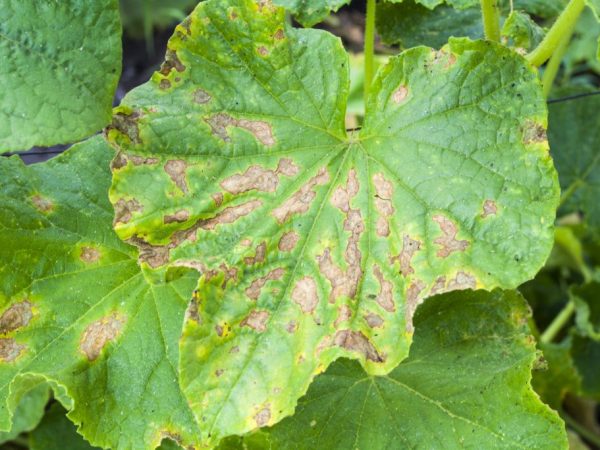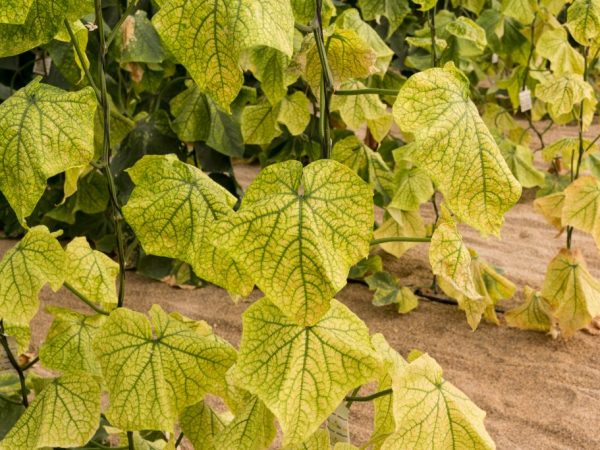Treatment of root rot in cucumbers
Root rot in cucumbers is a fairly frequent phenomenon, it is caused by various pathogens. How to protect plants from this serious painful condition and prevent plant death? Experienced gardeners know the answers to these questions.

Treatment of root rot in cucumbers
Symptoms of the disease
Signs of the disease appear after transplanting the culture to a permanent place. The earlier the cucumbers become infected with the disease, the more damage will be done to these plantings.
The symptoms of cucumber root rot are as follows:
- the root collar and roots become brown;
- leaves on affected crops turn yellow and wither;
- the ovary dries up;
- cucumbers remain underdeveloped;
- the main root becomes dark brown, rotting over time;
- the plant gradually withers and dies.
The painful condition progresses rapidly at temperatures below 16 and above 27 ° C. Signs, as a rule, do not appear in seedlings. Plants need to be treated in a timely manner, otherwise they will die.
Causes of the disease
The main reasons for the development of root rot in cucumbers are unfavorable conditions for growth and development. The presence of infection aggravates the state of the culture.
The acidity of the soil also affects the occurrence of the disease. The pH acidity is optimal for the spread of infection, which is 5-6.
The increased humidity in the greenhouse also adversely affects the growth of plants. At the same time, the roots suffer from a lack of air, and are affected by phytopathogens. Watering crops with cold water is also unacceptable, they suspend their growth, and sometimes the roots simply die off. The affected root system opens the door for infection to penetrate, which quickly spreads to all organs and healthy tissues.
With insufficient watering, the root system dries up and is affected by pathogenic microbes. The situation is aggravated by the increased concentration of salts in the soil.
Causative agents of the disease
The causative agents of the painful condition are various microorganisms. The most dangerous are:
- Pythium debaryanum - these pathogens in most cases infect the root system during germination, it darkens and begins to rot. The cotyledons and emerging leaves turn yellow. The pathogen infects not only cucumbers, but also many other crops.
- P. ultimum is a fungal pathogen, except for cucumbers, parasitizes on more than 140 species of crops. Its spores are spread by nematodes.
- aphanidermatum - Dangerous for more than 85 types of crops, but primarily affects cucumbers, tomatoes and legumes. The fungus multiplies during the molt of the bark in the affected tissues. The secondary bark protects the seedlings from infection, and they become resistant against the pathogen.

High humidity is dangerous
The causative agents of an infectious disease infect a culture under favorable conditions for them. Gardeners should not allow these combinations that are dangerous for the culture: high humidity in the greenhouse, dry roots, high acidity, too low and high temperatures.
Prophylaxis
It is possible to reduce the risk of root rot disease in a culture by growing seedlings on rootstocks that are resistant to pathogens: semi-cultivated pumpkin species Cucurbitae ficifolia and Lagenaria siceraria. They are not afraid of too low or high air temperatures and waterlogged soil, root rot does not affect these plants.
Reed grafting provides the highest survival rate of crops. The rootstock should be in the cotyledon period when inoculated, and the scion should form the first true leaf.
Breeders have developed hybrids that are highly resistant to root rot.
The introduction of a solution of some microelements into the soil, for example, MnS04 and ZnS04, 0.25 g per bucket of water, helps to increase the resistance of the crop to a disease state and significantly affects its yield.
Protection methods
There are many ways to protect yourself from a painful condition. Gardeners should use these methods, which can significantly reduce the risk of spreading infection:
- Disinfect and warm up the seeds when planting.
- For peat pots, it is recommended to use equal parts of turf, humus and peat. Compost mixes that have been biologically sterilized for 2 years are also suitable. They can also be steamed before use.
- To carry out the obligatory disinfection of the soil and utensils for seedlings.
- Use cassettes with mineral wool corks and cubes.
- Purchase new sterile mats.
- Water the seedlings with warm water.
- Try not to overmoisten the soil.
- Avoid soil salinization.
- Remove the remnants of diseased plants in a timely manner.
- Use chlorine-free fertilizers.
- Compost organic matter before spreading (at least 6 months).
- Grow seedlings on rootstocks that are resistant to painful conditions.
When the first symptoms of the disease are detected, “rejuvenate” the culture: lower the stem to the ground to form new and healthy roots. The soil is poured onto the stem as the roots are formed. The soil is treated with fungicide solutions.
Biological methods
Effective biological agents will help protect crops from the disease, regardless of its cause: Integral, Gamair, Baktofit, etc. Experts recommend treating cucumber seeds before sowing.
To limit the spread of pathogens in the soil and to carry out treatment, you can use Trichodermin, Glyocladin. They contain antagonist fungi, the solutions should be applied to the moist soil prepared for sowing. Some gardeners, when planting seedlings, are treated with preparations of the base of the stems. After a week, root treatment of the cultures is carried out. According to research by specialists, these measures can reduce the number of dead seedlings by 3 times and increase the yield by 3 kg / m2 per season.
Chemical methods
Experts recommend soaking containers for seedlings in disinfecting solutions for prophylaxis. The soil must be treated with sterilizers such as Methyl Bromide.
Seeds should be treated with Thiram a month before sowing. To increase the resistance of the culture to root rot of cucumber, the preparations Sprout, Narcissus, Amulet, etc. allow.
Protection by folk remedies
Vegetable growers also treat cucumbers with folk remedies. Powdered with chalk, coal or ash, sprinkle the root collar of cucumbers in a greenhouse. This method allows you to heal wounds on the affected organs and stop the spread of a dangerous disease.
A solution prepared from 3 tbsp allows to save the plants. spoons of chalk, 1 tsp. vitriol and 500 ml of water. The lower part of the stem and the root part of the culture are treated with a chatterbox. This treatment brings a favorable outcome.
Timely prophylaxis with folk remedies and cacao from root rot and prevention of favorable conditions for the spread of infection can save crops from a disease state. Vegetable growers should remember that any disease is easier to prevent than to cure.


